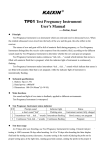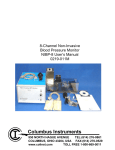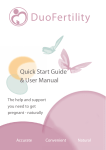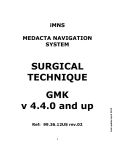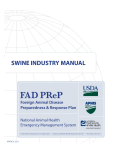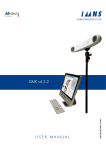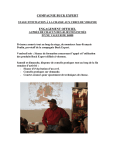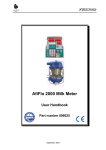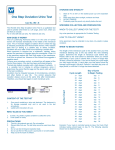Download Ovascan Owner`s Manual
Transcript
OVASCAN Instruction Manual Animark Inc. 876 Ventura Street Aurora Co 80011 303-343-8342 / 800-532-4048 www.Animark.us [email protected] 1 Table of Contents Table of Contents.................................................................................................................... 2 Welcome ........................................................................................................................................ 3 Introduction.......................................................................................................................................... 4 Why The Ovascan Works for Ovulation Prediction?.............................................................................. 4 Charting Your Readings.................................................................................................................... 5 Ovascan Instrument Features .............................................................................................................. 7 On / Off Button ................................................................................................................................. 7 Run / Hold Button ............................................................................................................................. 7 Charger Jack .................................................................................................................................... 8 Probe Jack ....................................................................................................................................... 8 Ovascan Set Up................................................................................................................................... 8 Probe Disinfection................................................................................................................................ 9 Using The Ovascan With Mares ......................................................................................................... 10 Charting Readings ............................................................................................................................. 11 Taking Readings............................................................................................................................. 11 1. High readings / Air introduced. .................................................................................................... 14 2. Ovulatory disorders..................................................................................................................... 14 3. Silent heat .................................................................................................................................. 14 4. Abnormally low readings............................................................................................................. 15 5. Continued abnormally low readings............................................................................................. 15 6. Twin ovulation............................................................................................................................. 15 7. Seasonal variations .................................................................................................................... 15 8. Introduction of drugs / hormones................................................................................................. 16 Using the Ovascan instrument with cows............................................................................................ 16 The cow’s cycle .............................................................................................................................. 16 Using the Ovascan for your particular operation.............................................................................. 16 1. Cows detected in standing heat .................................................................................................. 17 2. Cows not detected in heat........................................................................................................... 17 3. Post-Breeding check / late ovulation ........................................................................................... 18 Testing your Ovascan ........................................................................................................................ 19 Ovascan trouble shooting guide ......................................................................................................... 20 Troubleshooting cont.. .................................................................................................................... 21 Care and cleaning.............................................................................................................................. 21 Battery care instructions..................................................................................................................... 22 Owner responsibility for return shipping.............................................................................................. 22 Warranty and service ......................................................................................................................... 23 Warranty validation......................................................................................................................... 23 Warranty service............................................................................................................................. 23 Service after warranty period .......................................................................................................... 23 Warranty exclusions ....................................................................................................................... 23 Voided warranty.............................................................................................................................. 24 Ovascan monitor accuracy................................................................................................................. 24 Customer service /assistance............................................................................................................. 24 Summary ........................................................................................................................................... 25 Other instruments by Animark ............................................................................................................ 26 2 Welcome Animark is pleased to welcome you to our growing family of satisfied customers. Our company was founded on the principles of quality, integrity and service. As we grow, we continue to practice these principles. Animark pioneered and developed ultrasound pregnancy detection for animals. Among our many other successful instruments are: Boveq Pregnosticator Pregmatic-3 Ovatest We have since added several other products to our line, including the new Pregtest and Pregscan. Each type of Animark instrument can do its individual function better than any other product in its class. Better accuracy, better performance, better value. With the purchase of your Ovascan ovulation monitor, you have joined a worldwide group of progressive breeders and veterinarians who are realizing the benefits of today's electronic technology applied to animal sciences. Animark's continued research and development has made us the world leader in the field. Our growing list of enthusiastic customers is testimony to Animark's dedication to integrity and service. To obtain the maximum benefits from your Ovascan ovulation monitor, please read this manual carefully before attempting to use the unit. Thank you for the confidence you have shown in Animark with your recent purchase. We look forward to serving you in the future. 3 Introduction Many small to mid size breeders rely on heat indications to determine the best time to breed their animals. Heat can be an indication that ovulation is imminent but is not always accurate. Ovulation can actually take place before, during, or after visible heat. The Animark Ovascan ovulation detector’s technology is based on a well-documented fact that the chemical and electrical characteristics of mucus in a healthy animal's vagina will change in a predictable pattern from the beginning to the end of an ovulation cycle. It has been established that, as a result of the cyclic hormonal changes, there are also changes in ion concentration within the vaginal and cervical mucus of most mammals. By measuring and recording these changes in ion concentration, you can predict and confirm ovulation. Why The Ovascan Works for Ovulation Prediction? The Ovascan instrument utilizes the principles of electricity to identify the various ion or electrolyte concentrations. Changes during the reproductive cycle (see Fig 11) have a direct impact on the levels of ion concentrations present. During the reproductive cycle the electrical readings of the vaginal mucus will change in direct relation to cyclical changes in hormones like estrogen and progesterone. The presence of estrogen or progesterone will change the electrical characteristics (ion concentrations) of the vaginal mucus thus allowing the operator to measure these changes. Estrus will lower the readings and progesterone will raise the readings. Just before ovulation, there is a flood of estrogen, which affects the ion concentration, lowering Ovascan readings, and indicating the onset of ovulation. This is followed by a shift to progesterone dominance, which marks when ovulation is confirmed. The remainder of the reproductive cycle should stay fairly consistent. The Ovascan accurately measures these changes and displays them as an arbitrary numerical reading. By tracking these readings, you can effectively identify when ovulation has taken place as well as identifying when ovulation is expected to take place. This allows you time to plan for the insemination. With the Ovascan’s ease of use combined with a simple digital readout, you can identify all of your animal’s reproductive cycles easily. Incorporated into a well-managed breeding program, the Ovascan will prove to be an invaluable tool for years to come. 4 Fig 1-1 The egg is viable for fertilization for only a few hours once released. This can be as few as 8 hours. If the egg is not fertilized within this time, you will have to wait for another cycle. Using the Ovascan to predict and identify when your animal has ovulated will reduce covers, and improve pregnancy rates. The Ovascan is a breeding management tool, like a thermometer or speculum. Like any new tool you need to take the time to learn how to use it and increase your proficiency. It is not necessary to be a veterinarian: The Ovascan may be used by the knowledgeable breeder. Charting Your Readings Charting or plotting the readings from your Ovascan is the one crucial requirement for identifying and predicting ovulation. Consistency is the key. The more accurate your data, the better your results will be. As you take and record readings for each individual animal, make sure the conditions in which you take your readings are the same each day. For example, always take your readings the same time each day if possible. This ensures a similar condition and more accurate readings. Readings can vary slightly throughout the day based on activity, diet, urination and other variables. Once a mare is plotted through one entire cycle, you will have a chart that should be very clear as to when your animal actually ovulated. This historical information is critical to ensure your ability to accurately predict the next ovulation. Each cycle should be similar for each individual animal. Readings will vary between animals but each animal should show similar patterns. These patterns along with normal breeding indicators such as teasing, heat detection, etc., can then be interpreted to 5 predict actual ovulation. During the course of a normal reproductive cycle in any mammal there are several things that happen prior to ovulation. The first notable and measurable activity is a flood of estrogen into the animal. This precedes a release of a hormone called LH (Luteinizing Hormone). The purpose of this hormone is to dissolve the follicle holding the egg. When the follicle is dissolved the undersized egg is released. The viability of the egg after release can be as few as 8 hours. The ideal scenario for fertilization is having semen present 12 to 24 hours before or as soon after the release of the egg as possible. Having fresh, active semen waiting is ideal. This means that the best time for breeding or inseminating is the DAY BEFORE ovulation or as close to it as possible. Research has shown that if an egg is fertilized later in the eggs maturity, the chances of absorption or abortion are much greater. The percentage of aborted pregnancies has been shown to be as high as 34%. By charting your readings for each animal with the Ovascan you can get the advance notice required to inseminate before the actual ovulation. In summary, you want to make sure that fresh active sperm is available to the egg as soon after the egg’s release as possible, but not later than a few hours. This is why, from experience, many breeders breed every other day during heat. This practice can be both wasteful and expensive. By charting the readings of the Ovascan, you will accumulate practical information allowing you to make informed decisions about when to breed your animals. 6 Ovascan Packing List Figure (1-2) Ovascan Unit Ovascan Probe Charger Carrying Strap Carrying Case Tracking Chart Instruction Manual Container Warranty Card Performance Fluid Fig 1-2 Ovascan Instrument Features The Ovascan has a very simple interface for ease of use in the field. On the face of the instrument there are two buttons and two jacks. On / Off Button The On / Off button is the red push in / push out button located in the far right as you look at the face. Push in for On and push again for Off. Run / Hold Button The Run / Hold button is a push in / push out button that controls the number display. When you want to lock in the displayed number press once to hold or freeze the reading. The Run / Hold button should be set to Run when first taking 7 your reading. Once the displayed reading settles down (no more than 20 seconds) press the Run / Hold button to freeze or hold the number so you can record it on your tracking sheet. Charger Jack Plug the charger into charger jack and then into any wall outlet. Charge overnight or for at least 4 hours (preferably 16 hours) to charge batteries. Make sure the unit is off before connecting the charger. Probe Jack Plug the Sensor or probe cord into this jack. Make sure the unit is off before connecting probe cord. Fig 1-3 Ovascan Set Up To set up and use your Ovascan please follow these simple steps. 1. Connect the ends of the carrying strap to D-rings at either side of the unit. Place the strap around your neck so that the unit hangs in front with the screen facing you. 2. Connect the sensor or probe to the probe jack on the front face. 8 3. Turn the instrument on with the Run / Hold switch in the "Run" position. The display should read around 700 with the probe in place. 4. The Run/Hold switch must be in the "Run" position while readings are being taken. Be sure the unit is turned OFF when not in use. Both switches are of the push-on/push-off type, so you simply push the button to change from “Run” to "Hold" and back or from “On” to “Off”. (Please Note: The probe must be cleaned, disinfected, and rinsed thoroughly between each animals readings. See the Probe disinfection section.) Probe Disinfection Before you use the Ovascan probe, visually inspect the probe for any oxidation or any other discoloration. If oxidation or discoloration is detected the probe will need to be thoroughly cleaned, disinfected and thoroughly rinsed prior to introduction to your animals. Once the entire probe surface is completely cleansed of oxidation, it must be disinfected. Oxidation will not hurt your animal but will affect your readings. Animark recommends the use of “Novasan” or any other similar disinfectant. If you are unsure what to use, ask your veterinarian or veterinary supply outlet to recommend an appropriate disinfectant. Between animals you will want to clean any mucus from the probe, disinfect and again thoroughly rinse the probe. Disinfectant can irritate the vaginal lining and can also act as a spermicide in your animals. That is why it is so important to make sure the probe is 100% clean between readings. See steps below. 1. WIPE the entire surface of the probe from the handle to the tip with a dry paper towel to remove any mucous. 2. WIPE the entire surface of the probe from the handle to the tip with an undiluted disinfectant applied to a moistened paper towel or disposable wipe such as a gauze square or cloth baby diaper. It is not necessary to disinfect the rubber handle of the probe. 9 3. SOAK the probe by immersing it in a diluted solution of disinfectant made up according to the manufacturer's directions and allow it to stand for at least 30 seconds. 4. RINSE the probe thoroughly with clean running water. This is a critically important step as the disinfectant could irritate or inflame the animal’s vagina as well as kill any sperm introduced after the measurement. 5. Wipe down with a dry paper towel. 6. Repeat these steps before testing each animal. 7. Please Note: After each day's use, clean and dry the probe and store the meter and probe in the case. Oxidation may be reduced by storing the probe in a plastic bag. Using The Ovascan With Mares In order to effectively predict the onset of ovulation, mares should be checked and charted daily. To prepare the mare for probe insertion, clean the vulva with soap and water and/or a tamed iodine spray, or as your veterinarian would recommend in preparation for a specular exam. Insert the disinfected probe between the parted vulva. Take care not to spread the vulva so much that air is allowed to enter the vagina. The introduction of air can alter the accuracy of the readings. Insert the probe at a slightly upward angle to clear the hip skeletal structure, then lift the handle slightly and gently slide the probe into the vagina along the horizontal path until a firm resistance is felt. The probe should be touching the cervix. Raise the handle of the probe slightly upward to drop the tip of the probe into the Vaginal pool located just below the cervix (See Fig 2-1). Twist the probe for 10-15 seconds to fully coat the sensor portion of the probe with vaginal mucus then hold for 10-20 seconds or until the reading settles down. It is normal for the readings to vary slightly while holding. Press the Run / Hold button on the instrument face at its lowest maintained number. The length of time you remain in each animal should be consistent. 10 If desired, hold the reading obtained until it can be recorded. Remove the probe gently and then record the reading. (See Charting Readings Section). Return the Run / Hold switch to the run position before turning off the Ovascan. Fig 2-1 Charting Readings It is essential to chart each individual animal’s readings separately. Each animal will have its own base line or standard readings and particular cyclic pattern. After you have charted one cycle for your mare, you will improve your ability to predict ovulation accurately. Animark has provided you with one tracking chart included in your instrument case. To get more you can copy the chart provided or download the chart from our website. The exact address is http://www.animark.us/animal_ovulation_prediction.html. Simply click on the Download sample Ovascan Chart located in the lower left hand corner. Clicking the highlighted text will automatically open an Excel spreadsheet on your computer. You can then save the document or print as many copies as you need. If you do not have a computer you can contact us at 303-343-8342 and we will be happy to send you as many tracking sheets as you need. Taking Readings It is important to take and record readings at approximately the same time each day. Consistency is the key to accurate readings and tracking. Track all readings 11 through at least one cycle and continue taking readings even after insemination to ensure accurate interpretation of results. Each mare will establish her own individual set of readings. A mare not in heat will generally read above 225. When she is in heat, she will develop a Basic Estrous Reading (B.E.R.) at around 225 or less. However, there are considerable variations from one mare to another because of individual hormone and nutritional conditions. During the first day or two of heat, the readings can be lower due to vaginal material being sloughed from the uterus through the newly relaxed cervix. As the uterus cleans up, the readings should rise to the animal's B.E.R. (See Fig 2-2). Four days prior to ovulation, there will be a drop in the readings. When you see this drop start, you know that your mare has selected a dominant follicle and can be expected to ovulate within about four days. This is of course based on the historical record for that particular animal. In some animals there can be one or more drops prior to actual ovulation. These “false peaks” (see Fig 2-3) are due to follicular selection being aborted and a new follicle being selected. This is why is it is so helpful to chart at least one full cycle in order to identify the animals “true peak”. Fig 2-2 12 During the early breeding season, it is normal to get readings of less than 100. These early season lows may last for several days. If this is the case, impending ovulation (within just a day or two) is signaled by the first increase in readings. During the warm summer months, mares stay in estrus for a shorter time and late in the season you should notice that the low readings prior to ovulation will be lower or deeper than earlier in the season. Fig 2-3 The "Double Dip" pattern in Fig 2-3 may require two services. This pattern can result from a surge of hormonal activity that is not enough to complete ovulation, followed by a second or sometime a third surge which does produce ovulation. The drop corresponding with ovulation (the second drop) will usually be deeper than the first (See Fig 2-3). It is most important to remember that each mare is different and will establish her own individual range on the Ovascan chart. Graph each animal and breed her in accordance to her specific pattern. The absolute numbers being recorded are not important but the pattern they develop is. 13 Abnormal Conditions (as indicated by Ovascan readings) 1. High readings / Air introduced. Some mares maintain a continuous reading well above the normal B.E.R., even as high as 400, usually indicating that air is present in the vagina. Whenever this occurs, it prevents good contact between the surface of the probe and mucus in the vaginal tract. If air is accidentally introduced with the probe, it can be manually expelled via rectal palpation or, if a palpator is not readily available, let the animal walk around for an hour or two before trying to take another reading. Normal activity will generally result in the natural expulsion of the air. If the introduction of air continues to be a problem, you may want to try the following tip. Take a new standard sponge and cut a small hole in it. Make sure the hole is smaller than the probe end. Wet the sponge and place against the vulva. Slowly insert the probe through the hole and into the animal’s vaginal tract. This should reduce the amount of air being introduced. In rare occasions, a "wind sucker" that has chronic aerovagina will require treatment before the Ovascan device can be used with good results. 2. Ovulatory disorders ! ! ! Silent Heat – This is the most common disorder. See “Silent Heat” below. Anovulation – Heat without an actual ovulation. Lutenized unruptured follicle – This occurs when the follicle is present and continues to grow but is never released. The Ovascan may not be able to specifically identify the individual disorder present but will certainly indicate the there is a potential problem. Please consult your veterinarian if you suspect any of these disorders. Your vet can usually diagnose and treat any of these rare disorders. 3. Silent heat A "silent heat" mare is usually an animal that does not show any readily observable heat indicators or responses when teased. Using the Ovascan to actually detect when she does ovulate is just as simple as that of any other mare. Take readings every day and chart her activity just as you would a regular mare. Mares showing no change in Ovascan readings may have a persistent corpus luteum or a lutenized 14 unruptured follicle. Please consult your veterinarian if you suspect any abnormal ovulatory conditions other than a silent heat. 4. Abnormally low readings Abnormally low readings may be caused by a continuing uterine infection. This is similar to the shedding of organic matter mentioned above in the description of the normal B.E.R, but if it continues for three or more successive daily readings, it is a signal of the need for prompt diagnosis and treatment by a veterinarian. These readings can also be expected if organic material is being sloughed after parturition during the foal heat. 5. Continued abnormally low readings Continual very low readings can also be caused by urine in the vagina. The urine pooling mare should be treated for this condition before normal conception can be expected, and certainly before normal readings can be taken with the Ovascan instrument. 6. Twin ovulation It is possible for some mares to produce two eggs during the ovulatory cycle. This is the result of the mare ovulating from two ovaries within a two or three day period. Usually a “W” shaped pattern on the Ovascan chart can be observed. If you see this pattern, you should consider the possibility of twin ovulation. In such cases, especially when the mare has a history of twinning, the Pregscan pregnancy detector or palpation should be used to confirm conception of one or both of the eggs. This pattern will not always indicate twin ovulation but you should be aware of the possibility. 7. Seasonal variations In the mare, there is a tendency for the pre-ovulatory drop to be rather shallow at the beginning of the season and then become much deeper later in the year. For example, when the B.E.R. remains consistently around 225, during February and early March, one might see readings drop to only 80 to 120 prior to ovulation. Starting around mid-March until mid-May, they may be seen to drop to a range of 60 to 90, and after about May 15th, they may be seen to be much lower to around 35 to 60. You may also observe that during the early part of the breeding season, some mares seem to tease warm to hot and will remain in the range of 195 to 120 for 15 many days, sometimes even several weeks. Readings should be continued daily, without breeding, until a reading less than 120 is seen. Of course, these specific months do not apply for users in the Southern Hemisphere, where for February it would change to September, etc. 8. Introduction of drugs / hormones Introduction of drugs or hormones can and will affect your Ovascan readings. If your veterinarian is introducing drugs or hormones into your animal, follow the veterinarian’s guidance and instructions for breeding. The Ovascan unit may not show a normal dip pattern as these drugs or hormones tend to by-pass the mare's natural estrogen release pattern. Using the Ovascan instrument with cows The cow’s cycle Cows will usually cycle every 21 days. The estrus period and visible heat usually lasts 12- 24 hours. The cow’s ovulatory cycle can be tracked and ovulation predicted and confirmed just as with the horse (See “Why The Ovascan Works for Ovulation Prediction?” section) or almost any other mammal for that matter. Most of the time, the hormone that triggers ovulation (luteinizing hormone, or LH) peaks around mid-estrus, and the lowest Ovascan readings will be found during the middle of the estrus. This is usually a direct correlation with the LH peak. (See Fig 3-1). Studies have shown that for the highest conception rates, cows should be bred during this time. Ovulation will usually occur within 24 hours after the LH peak or from the Ovascan’s lowest reading. Using the Ovascan for your particular operation The Ovascan instrument is a tool like any other in your breeding arsenal. You will need to determine the best time and place to take your readings to ensure maintaining efficiencies with your standards of operation. The following section is for general suggestions only and how you use the Ovascan is entirely up to you and how best to incorporate your new tool into your daily operation. Dairy operations will clearly differ from other cattle operations. These recommendations are based on an overall objective of achieving a 12-month calving interval and a higher than average conception rate. 16 1. Cows detected in standing heat On average, 50% -60% of cycling cows are detected in heat using traditional methods. Provided an adequate first service conception rate is being achieved, these cows may be bred in the usual manner. However, if you feel that a higher conception rate is desirable, the following procedure may be useful: a) Take an Ovascan reading soon after the cow is first observed in heat. Reading should be in the range of 50 -60 or thereabouts. b) Take a second Ovascan reading after 6 -8 hours. ! ! ! If reading is similar (+ or -10) to first reading, then breed now. If reading is lower by 10 or more, take an additional reading in 4 -6 hours. Breed when reading is similar to or higher than previous reading. If reading is higher by more than 10, cow is ovulating early and should be bred immediately. If cow returns to estrus, remember to breed earlier than usual at the following estrus. c) Follow post-breeding check. 2. Cows not detected in heat Cows not detected in heat by 40- 50 days post-calving should be monitored with your Ovascan unit. Cows in the luteal phase of the cycle (usually from the third to sixteenth day of the cycle) will give relatively high Ovascan readings (90 or greater). Monitor these cows as follows: a) Take readings every other day. b) Readings will begin to decline 2 -3 days prior to estrus. Take readings daily at this stage. 17 c) When readings have declined to 50 -60, cows must be probed at least morning and evening, or preferably every 6 -8 hours. d) When a reading does not show a decline from the previous value, or is slightly higher, the cow should be inseminated. e) Follow post-breeding check. 3. Post-Breeding check / late ovulation Late or delayed ovulation: An Ovascan reading should be taken 24 hours after breeding. Cows ovulating normally will show a reading higher than the one taken at time of insemination. However, late ovulators will usually have a reading similar to that at the time of breeding. If a high probability of conception is desired, you may elect for a second breeding of these cows at this time. After 22 days you should check the bred animals with the Pregscan to verify conception. This will minimize your open animals and give you time to re-breed. See the last page of this manual, our website, www.animark.us or call us for more information on the Pregscan. 18 Fig 3-1 Testing your Ovascan To test your Ovascan and ensure the readings you are taking each day are accurate, you may wish to set up a performance test liquid. To do this, simply take the Performance test liquid container included in your case and fill it with tap water. Insert the probe into the container and note the reading. Then take a pinch of salt and add it to the water. It is not necessary to add too much salt, as much as you might put on a baked potato is fine. Take another reading with the Ovascan probe and note the reading. Again add another pinch of salt and take another reading. Each time that salt is introduced into the tap water, the readings on your Ovascan should drop. If each time salt is introduced the probe takes a lower reading, the instrument is working correctly. If the readings do not drop, check the probe for oxidation. If oxidation is detected then clean and disinfect the probe as per the “Probe Disinfection” guidelines and test again. 19 Ovascan trouble shooting guide Problem Unit does not turn on. Unit on with out probe, reading is not at 88. Probe not taking a reading Probe readings unusual Numbers do not change Possible Cause Solution Battery pack discharged. Charge Unit. If it does not hold a charge call Animark. Battery pack requires replacing. Send to Animark for repair. Short in electronics. Send to Animark for repair. Malfunctioning electronics. Send to Animark for repair. If reading is within 5 numbers unit is ok. No action required Run / Hold button engaged Should show -1, press Run / Hold button Probe not connected. Battery pack discharged. Check probe connection. Charge Unit. If it does not hold a charge call Animark. Probe Faulty Test probe, if not functioning Call Animark. Run / Hold button engaged Press Run / Hold Button, take reading. Oxidation on probe Ovulatory Disorder Clean and disinfect Probe. See Ovulatory Disorder Section, Check with Vet Run / Hold button engaged Press Run / Hold Button, take reading. Short in electronics. Send to Animark for repair. Malfunctioning electronics. Send to Animark for repair. Animals readings vary greatly day to day Oxidation on probe Clean and disinfect Probe. Animal cycle unkown Chart animal’s reading for at least one cycle. Probe jack faulty Call Animark Probe Faulty Test probe, if not functioning Call Animark. Charge Unit. If it does not hold a charge call Animark. Charge Unit. If it does not hold a charge call Animark. Charge Unit. If it does not hold a charge call Animark. Low Battery Low battery Indicator Low Battery Display seems dim Low Battery 20 Troubleshooting cont.. If your Ovascan system fails to function properly, first charge it for at least four hours, then check for power. When the unit is turned ON, if the LO-BAT indication still shows at the left of the display, try charging the unit for eight (8) more hours. If the low charge indicator still appears, return the unit and the charger to Animark for service. If the unit has adequate charge, but readings are erratic: 1. First make sure the electronic unit itself is measuring correctly by turning it on with the probe disconnected. The display should read around 88. If it passes this test, the Ovascan meter is working properly. 2. If this is not the problem, connect the probe to the unit, turn the unit ON and test the unit as described in “Testing Your Ovascan” section. 3. If the chart above does not address your particular concern, contact Animark repair ((303) 343-8342) for further instruction. NEVER remove the cover of your Ovascan ovulation monitor. Components are protected by a chemical spray against humidity and corrosion. Any attempt at repairing the unit will void the warranty. Care and cleaning Although the Ovascan unit is designed for rugged use, excessive rough handling is undesirable. Sharp bends or kinks in the cable, especially near the ends, should be avoided. After field use, the instrument should be wiped clean of any moisture, dirt, or organic material, dried and placed back in the case. Occasionally, the case may be cleaned with a light duty general purpose household cleanser. NEVER USE ABRASIVE CLEANERS OR CAUSTIC LIQUIDS ON THE CASE, FACEPLATE, OR ANY OTHER PART OF THE INSTRUMENT. A charge will be assessed if a unit requires excessive cleaning prior to service. 21 Battery care instructions The Ovascan device is powered by a rechargeable nickel-cadmium battery pack. When fully charged, this pack will operate the instrument for over 6 hours. The battery should be charged if the LO- BAT indicator (on the left side of the display) comes on. A full charge takes about 16 hours - typically overnight. The charger plugs into any standard 110- 120 volt outlet (or 220 volt source with the appropriate charger/converter). The unit should be turned OFF when not in use and especially when charging. Leaving the unit ON after the battery is fully discharged may result in damage to the battery. NOTE: Battery damage caused by excessive drainage is not considered ordinary use and is not covered by the warranty. The cells in this pack discharge to some extent even when the unit is not turned on, so it is necessary to recharge the batteries occasionally even when the instrument is not being used. The batteries will discharge (without instrument use) over a period of weeks or months, depending on the outside temperature. They discharge faster when the outside temperature is high. If the unit is not to be used for some months, it is a good idea to check it occasionally for battery charge. If the unit has been stored for a long time (several months) without periodic recharging, the batteries can occasionally lose capacity and then will not operate for the normal time on a single charge. The battery pack can be restored to normal by cycling the batteries several times. Cycling means to recharge for 16 hours, then discharge completely by leaving the unit on until the LO-BAT signal shows on the left side of the display and then recharge it again. Similarly, if the batteries are left on charge for too long a period of time (several Weeks) they can lose capacity. In this case restore by cycling as indicated above, this time starting by discharging. Owner responsibility for return shipping It is the responsibility of the owner to pack the instrument securely for return and to pay shipping and insurance costs to and from the repair center. 22 Warranty and service All instruments manufactured by Animark, Inc. are warranted to be free of defects in materials and workmanship for a period of two (2) years from date of purchase. Within this time, the instrument or part of it will be repaired or replaced at our discretion if found to be defective by our examination. Warranty validation To validate your warranty, the Warranty Registration Card included with your instrument must be completed and returned to Animark, Inc., 876 Ventura Street, Aurora, Colorado 80011, within thirty (30) days of purchase. This warranty is nontransferable and applies only to the original Purchaser. Cables and sensors are warranted for ninety (90) days from the date of purchase. Warranty service If your instrument requires service, please call Animark, Inc. before shipping the unit to the repair center. Some service problems can be diagnosed and corrected by telephone. If the unit does need to be returned for service, we can suggest suitable packaging and shipping procedures. Service after warranty period After your warranty expires, any necessary service will be provided promptly, carefully, and at the lowest possible cost to the owner. Replacement cables and sensors may also be ordered directly from Animark. Please call Animark at 303/ 343-8342. If you are calling long distance, remember the difference in time zones. The best time to call is between 8:30 A.M. and 4:30 P.M. (Mountain Time) Monday through Friday, except holidays. Warranty exclusions This warranty does NOT cover damage to the instrument nor injury or consequent injury to any animal resulting from any cause, including abuse, failure to following operating instructions, improper handling or unauthorized attempts to repair the 23 equipment. Batteries, if not properly used (see section in Battery Care Instruction) are excluded from the warranty. Voided warranty This warranty is void if attempts at repair have been made by anyone other than authorized Animark personnel. Ovascan monitor accuracy The purpose of the Ovascan instrument in breeding is to determine the optimum time to breed an animal in order to achieve higher conception rates. This does not guarantee conception to a single service, nor does it guarantee conception in any given animal. Properly used, the instrument will reduce the average number of services per conception in nearly all operations. Animark does not make any claims or guarantees as to the effect of performance. Customer service /assistance Animark personnel are always happy to provide telephone assistance or, when possible, to visit an owner who needs more intensive instruction for use of the Ovascan. Animark has an existing network of breeders who are willing to review their operation and use of Animark equipment. If you are provided an existing customer reference please understand that they are simply happy customers that do not mind taking calls on occasion. Animark does not compensate them in any way, so please show them the respect and patience they deserve. If after you have become proficient with you Animark instrument you would like to extend your knowledge and help, please contact us. We would love to add you to our growing network of satisfied breeders. Also please understand that we are equipment manufacturers who produce the best equipment in its class. We do not breed our own animals and often times are not as proficient as our seasoned users. You in the field are the experts in its use. We can, of course, provide basic instruction and explain the operation of the instruments. You will, however, obtain the high degree of accuracy you need in your operation by taking the most important action... PRACTICE, PRACTICE, PRACTICE. 24 Summary This electronic method of detecting and predicting ovulation has been shown to be reliable in large numbers of animals. Consistency is the key factor in your continued success. Missing days and spotty testing will not likely provide you with the level of success you are looking for. Properly used, the Ovascan will provide a high degree of information on your animal’s ovulatory cycle. Animark does not make any claims or guarantees as to the efficiency of the instrument, nor is any other guarantee made or implied. Welcome to Animark! We value you As a customer! 25 Other instruments by Animark Ultrasound Pregnancy Detectors for Livestock Our electronic pregnancy detectors are highly accurate and easy to use. Used externally, they are more convenient and safer for the animal than palpation or internal ultrasound units. With Animark ultrasound instruments, you can expect to ! ! ! ! ! Detect pregnancy as soon as 14 days after breeding. Check at your convenience, in 1-2 minutes. Check as often as you like, any time until birth. Cull, keep, or rebreed on accurate information. Save on vet bills. The Pregscan For Mares and Cows The ultrasound instrument displays the exact location of density changes or tissue interfaces in your animal. When properly aimed at the uterus, the display will show a pattern or spike indicating pregnancy and no spike if the animal is open. Because the animal's uterus changes density soon after conception, you can identify pregnancy as early as 14 days after breeding. This unit is specifically calibrated to recognize the tissue change upon conception in large animals. With sophisticated electronics and digital output, the Pregscan is 98% accurate at detecting pregnancy. The Pregtest For Miniature Mares, Llamas, Alpacas, Swine, Sheep and Goats Ideal for smaller animals Because palpation is not usually a practical option for smaller animals, an ultrasound (the Pregtest) is the best option available for the determination of pregnancy. The Pregtest is a fully external, A-scope ultrasound machine used for the detection of pregnancy in smaller animals. The Pregtest will provide accurate information about the reproductive status of your animals, allowing you to increase herd efficiency, decrease costs, and improve your profitability. The ultrasound instrument displays the exact location of density changes or tissue interfaces in your animal. When properly aimed at the uterus, the display will show a pattern or spike indicating pregnancy and no spike if the animal is open. Because the animal's uterus changes density soon after conception, you can identify pregnancy as early as 14 days after breeding. This unit is specifically calibrated to recognize the tissue change upon conception in smaller animals. With sophisticated electronics and digital output, the Pregtest is 98% accurate at detecting pregnancy. Please call us or visit our website if you require additional information about our superior ultrasound machines. 26



























